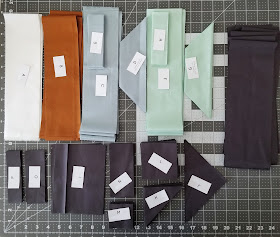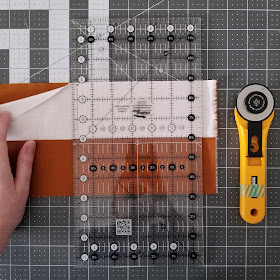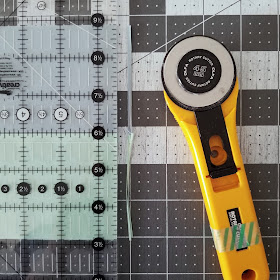In this last and final Vegas Wedding quilt post, I will be sharing a few tips for assembling the quilt top! I planned to get a full shot of my top finished this weekend, but....life happened so the photo shoot didn't 👎 You all will have to pretend that graphic below is the real thing for now 😂😉 I am SO excited with how it turned out though and can't wait to get some photos and share them with you!
 |
| The Vegas Wedding Quilt pattern can be found HERE |
The hardest part of assembling the top is lining up the angled seams of Blocks Two and Three with Block One. I have a tip I discovered while making my first Vegas Wedding Quilt that made it pretty much fool proof. But, first a tip for sewing Piece J....
When sewing a halved Piece J to a Block One, either finger press Piece J in half and line up the center crease with the center seam of Block One. OR you can just make sure the point on the triangle is lined up with the center seam too! Either method ensures that Piece J is centered on the block.
Alright, and now my tip for getting the angled seams of Blocks Two and Three to line up with the straight seams of Block One....Lay a Block One and Block Three, right sides together (RST) like shown in the photo below. Line up the left raw edges of both blocks. My Block Three is positioned a little lower than Block One in the photo below so you can have a better visual for how these seams will line up.
To make sure that the angled seams of Block Three line up with the straight seams of Block One, you want the point of the diagonal seam to line up with the edge of the seam it is pointing towards/needs to line up with.
An example of how these two seams will line up is below. The most important thing to pay attention to is the direction your angled seem is going. In the example below the diagonal seam, or seam that the bottom arrow is pointing at is going toward the right. So the point of that seam needs to line with the right edge of the straight seam below it or the seam that the top arrow is pointing at.
This tip will also apply to when you pin Blocks One and Block Two together. If you notice in the photo below, the angled seam on the left is going to the right, so the point of that seam will then be lined up with the right edge of the seam in Block One above it. Also, make sure the center seam of Block one is intersecting right through the center point of Block Two. I just simply fold back the center of Block One a little bit and adjust as necessary until that center seam intersects perfectly.
I like to pin as many blocks together as I can from each row before I start sewing. It really speeds it up if you chain piece as much as possible.
I also save time by not pressing the seams until each row is pieced. So after I sew the stack of blocks above, I'll lay them out on my floor, pin the units/blocks together from each row again - until the entire row is pieced, and then I will press my seams.
It helps to press the seams from each row in alternate directions so the seams nest together when you sew the rows together. For example, if the seams in Row 1 are pressed to the left then the seams in Row 2 are pressed to the right.
Here are all of my rows finished and ready to be sewn together...
After you've sewn the rows together you will need to square the quilt top by trimming 1/4" away from the outermost points around the perimeter. I do this by simply lining up the 1/4" marking on my ruler with the points on the quilt. Also, in example photo below, you will want to line up one of the horizontal markings with the horizontal edge of the corner. This ensures that your corner will be square or a 90° angle later.
I like to trim right up to the second point, move my ruler up so now I'm measuring 1/4" past the next point while making sure the ruler lines up with the previous point I just trimmed.
I hope you all found these tips for making the Vegas Wedding quilt helpful! Like always, email me at PenAndPaperPatterns@gmail.com or comment below with any questions! And use the hashtag #VegasWeddingQuilt when you share your progress on social media! I'd love to see how your quilts turn out!
Thanks!
Lindsey


















































